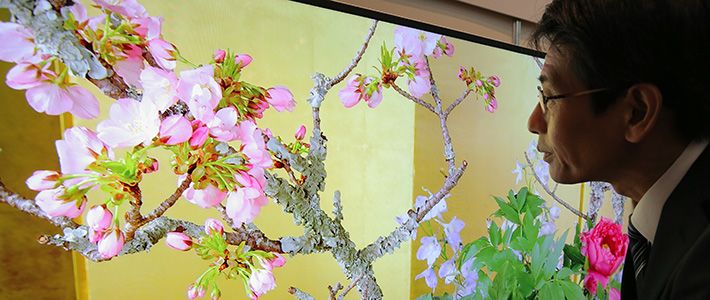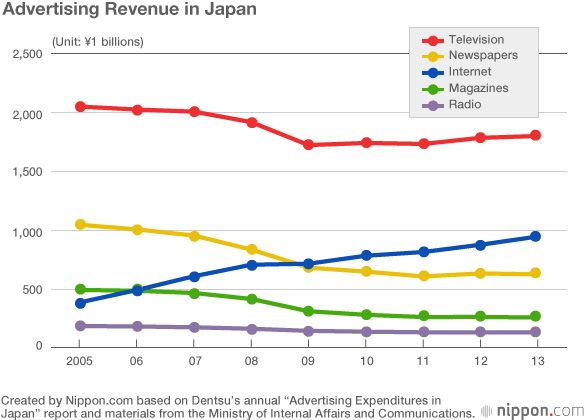
Will TV Be Dethroned as Japan’s Entertainment King?
Economy Society Culture Lifestyle- English
- 日本語
- 简体字
- 繁體字
- Français
- Español
- العربية
- Русский
Terrestrial television advertising in Japan generated over ¥2 trillion in annual revenue until 2006, but that figure fell in the wake of the global financial crisis and remained stagnant from 2009 to 2013, at around ¥1.7 trillion. By contrast, Internet advertising revenue doubled in less than a decade, reaching ¥0.9 trillion by 2013. Although television is still said to be the “entertainment king” in Japan, it is an industry in decline from the perspective of advertising revenue. The diversification of viewing habits and young people’s increasing indifference to television form the background to this downward trend.

Average daily television viewing time in Japan is now three hours and 40 minutes on weekdays and four hours and 10 minutes on weekends and holidays. This is actually an increase compared with the 1980s, according to statistics from the ministry of communications. However, on closer examination, it becomes apparent that long average viewing hours are due largely to senior citizens.


Generation Gap in TV Viewing
According to a 2013 survey conducted by the Ministry of Internal Affairs and Communications, Japanese people between the ages of 10 and 29 spend approximately the same amount of time online as they do watching television in real time. Those in their twenties, in particular, spend more time online than using any other type of media. By contrast, Japanese people in their sixties spend an average of more than four hours a day watching television, even on weekdays, which is more than twice the average viewing time among young people.
In Japan, television broadcasts include not only terrestrial television, but also the “broadcasting satellite” and “communications satellite” systems, known by the abbreviations BS and CS, respectively. However, junior and senior high school students seem to prefer watching clips from their favorite music and animation or variety and comedy shows on sites like YouTube and Niconico rather than watching those shows on television.
Despite occasional rises, audience figures generally have been decreasing steadily for television stations, which have had a direct impact on advertising sales. The end of analog broadcasting in 2011 ensured that viewers upgraded to new digital televisions, making it much easier to record shows for later viewing by simply choosing from the on-screen program list. Devices that can record multiple programs at the same time are also common.
For every ten people who watch a program on terrestrial television in real time, there are two people who record it to watch later, according to a survey that the Nomura Research Institute conducted in March 2014 on 7,500 people throughout Japan. The number is even higher for dramas and films, for which six to seven people watch a program later for every ten people who watch it in real time.
Television Broadcasting in Japan
| Terrestrial | NHK (public broadcaster) | 54 stations nationwide | ||
|---|---|---|---|---|
| Private broadcasters | NNN | Nippon TV, etc. | 30 stations | |
| JNN | Tokyo Broadcasting System, etc. | 28 stations | ||
| FNN | Fuji Television, etc. | 28 stations | ||
| ANN | TV Asahi, etc. | 26 stations | ||
| TXN | TV Tokyo, etc. | 6 stations | ||
| Independent and other | ||||
| Satellite | BS | NHK | BS1, BS Premium | |
| Free private broadcasters | BS-TBS, BS Fuji, etc. | |||
| Paid private broadcasters | Wowow Prime, etc. | |||
| CS | Core | 41 companies, 83 channels | ||
| General | 59 companies, 293 channels | |||
As of April 30, 2014.
An End to Traditional Broadcasting
The total digitalization of television in Japan has overturned the traditional broadcasting model, and now major private stations and satellite companies are starting to offer programs via paid services on the Internet. Some telecommunications companies have also begun providing video content. And since 2008, Japan’s public broadcasting organization NHK has been running the paid service NHK On Demand for viewing previously broadcast programs online.
In January 2014, Nippon TV launched a service that allows viewers to watch popular programs online for up to one week after they were originally broadcast. Commercials for the service are different from those that appeared during the original broadcasts. As viewing figures for the online service steadily rose, Tokyo Broadcasting System followed suit by launching a similar service in October 2014. By allowing viewers who have missed an episode of an ongoing drama series the opportunity to catch up, these free services can potentially increase audience figures for the subsequent episode.
At a September press conference, the chairman of the Japan Commercial Broadcasters Association, Inoue Hiroshi, announced that the five major private stations in the Tokyo area have agreed to start work on a free shared site that will offer previously broadcast programs to viewers, with revenue generated from commercials. However, before the plan can be put into practice, it will be necessary to obtain approval from affiliated regional companies and resolve other issues.
The Future is 4K?
Ultra-high definition “4K technology” has been turning more and more heads. Japanese manufacturers have already started sales of 4K televisions, and experimental 4K CS broadcasts began in June 2014. Telecommunications companies providing programs via fiber optic cables have also entered the 4K market.
Under the Ministry of Internal Affairs and Communications’ plan, experimental 4K BS transmission will start in 2016, targeting regular broadcasts in 2018.
The aim is to encourage consumers to purchase 4K televisions in the run-up to the 2020 Summer Olympics in Tokyo. However, a massive outlay will be required for television stations to provide continuous 4K broadcasts. For this reason, private companies, which have already invested heavily in the switch to digitalization, are considering their options carefully before proceeding.
Key Events in Japanese Television Broadcasting
| 1953 | Regular television broadcasting begins |
| 1958 | Tokyo Tower completed |
| 1960 | Color broadcasting begins |
| 1963 | First satellite broadcast between Japan and United States |
| 1964 | Tokyo Olympics broadcast via satellite to Europe and North America |
| 1971 | NHK General TV begins full-time color transmission |
| 1972 | Marathon live broadcast for the Asama-Sansō hostage crisis |
| 1978 | Japan’s first experimental broadcast satellite launched |
| 1989 | Regular satellite broadcasting begins |
| 1992 | Communications satellite analog broadcasting begins |
| 1996 | Communications satellite digital broadcasting begins |
| 2000 | Regular broadcasting satellite digital broadcasting begins |
| 2006 | Terrestrial digital broadcasting begins nationwide |
| 2011 | End of analog broadcasting (except for three prefectures in Tōhoku) |
| 2012 | Completion of switch to digital broadcasting |
(Originally written in Japanese and published on December 25, 2014. Banner photo: A 4K television at a June 2, 2014 ceremony in Tokyo to mark the launch of experimental 4K communication satellite broadcasting. ©Jiji.)